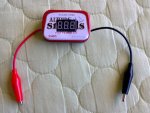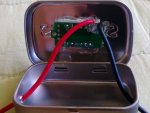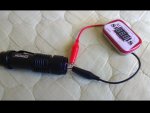- Joined
- Mar 29, 2013
- Messages
- 1,221
- Points
- 63
Hey guys, i have a new member of my measurement arsenal! My new, altoids (mini) voltmeter! The range on this is 3 volts - 30 volts. It's perfect for testing continuity and is very convenient, both sizewise and how it has alligator clips for easy testing!
The best part...No Batteries! It's battery-less!
Now,some pics!
The exterior:

Interior, kinda sloppy, but watever!

The clips:

Attached to my newest host kit, testing lead continuity

Press the tailswitch and the display lights up with a reading! 4 volts!

Up close LED display!

I love this voltmeter and plan to continue using it!
Any questions are welcome
Thanks for looking!
The best part...No Batteries! It's battery-less!
Now,some pics!
The exterior:

Interior, kinda sloppy, but watever!

The clips:

Attached to my newest host kit, testing lead continuity

Press the tailswitch and the display lights up with a reading! 4 volts!

Up close LED display!

I love this voltmeter and plan to continue using it!
Any questions are welcome
Thanks for looking!





